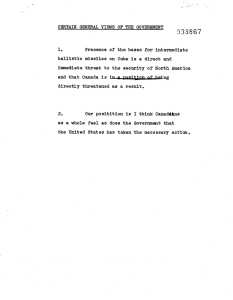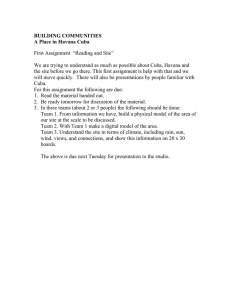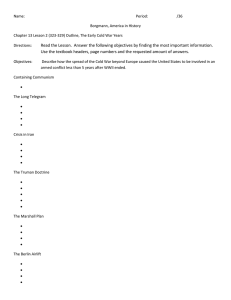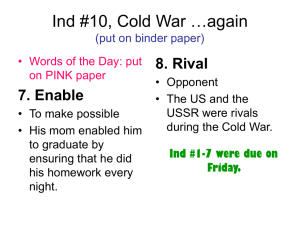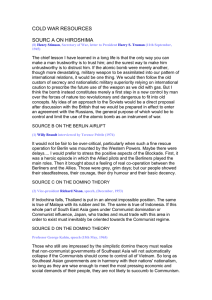Chapter 28 The cold War. US Interventions.doc
advertisement
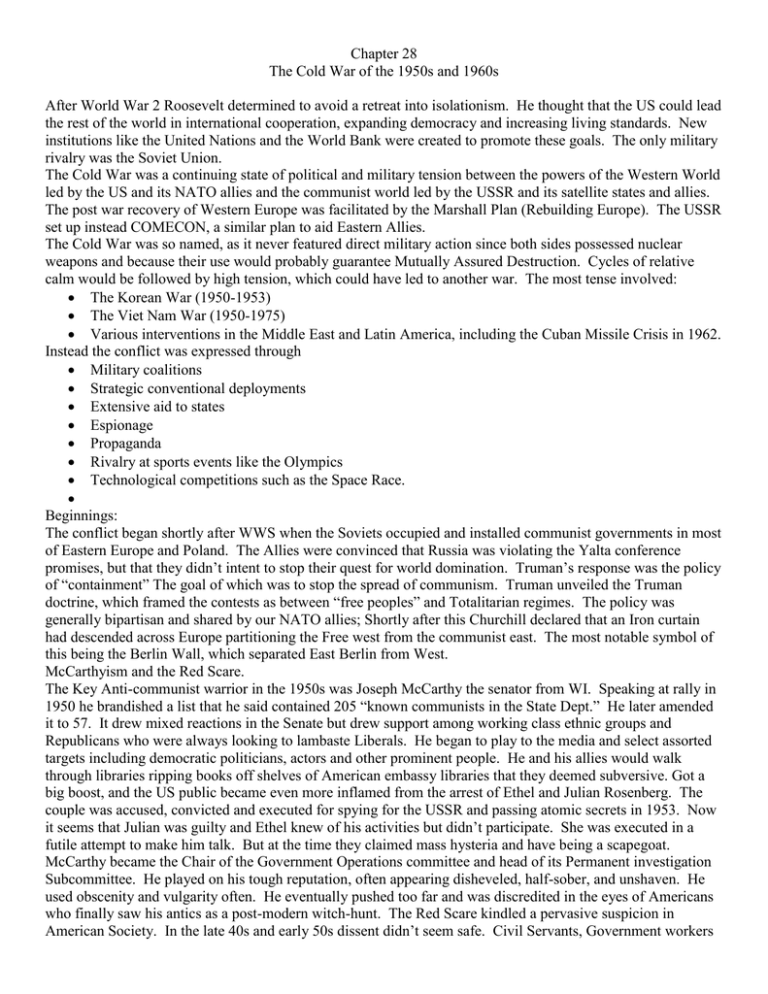
Chapter 28 The Cold War of the 1950s and 1960s After World War 2 Roosevelt determined to avoid a retreat into isolationism. He thought that the US could lead the rest of the world in international cooperation, expanding democracy and increasing living standards. New institutions like the United Nations and the World Bank were created to promote these goals. The only military rivalry was the Soviet Union. The Cold War was a continuing state of political and military tension between the powers of the Western World led by the US and its NATO allies and the communist world led by the USSR and its satellite states and allies. The post war recovery of Western Europe was facilitated by the Marshall Plan (Rebuilding Europe). The USSR set up instead COMECON, a similar plan to aid Eastern Allies. The Cold War was so named, as it never featured direct military action since both sides possessed nuclear weapons and because their use would probably guarantee Mutually Assured Destruction. Cycles of relative calm would be followed by high tension, which could have led to another war. The most tense involved: The Korean War (1950-1953) The Viet Nam War (1950-1975) Various interventions in the Middle East and Latin America, including the Cuban Missile Crisis in 1962. Instead the conflict was expressed through Military coalitions Strategic conventional deployments Extensive aid to states Espionage Propaganda Rivalry at sports events like the Olympics Technological competitions such as the Space Race. Beginnings: The conflict began shortly after WWS when the Soviets occupied and installed communist governments in most of Eastern Europe and Poland. The Allies were convinced that Russia was violating the Yalta conference promises, but that they didn’t intent to stop their quest for world domination. Truman’s response was the policy of “containment” The goal of which was to stop the spread of communism. Truman unveiled the Truman doctrine, which framed the contests as between “free peoples” and Totalitarian regimes. The policy was generally bipartisan and shared by our NATO allies; Shortly after this Churchill declared that an Iron curtain had descended across Europe partitioning the Free west from the communist east. The most notable symbol of this being the Berlin Wall, which separated East Berlin from West. McCarthyism and the Red Scare. The Key Anti-communist warrior in the 1950s was Joseph McCarthy the senator from WI. Speaking at rally in 1950 he brandished a list that he said contained 205 “known communists in the State Dept.” He later amended it to 57. It drew mixed reactions in the Senate but drew support among working class ethnic groups and Republicans who were always looking to lambaste Liberals. He began to play to the media and select assorted targets including democratic politicians, actors and other prominent people. He and his allies would walk through libraries ripping books off shelves of American embassy libraries that they deemed subversive. Got a big boost, and the US public became even more inflamed from the arrest of Ethel and Julian Rosenberg. The couple was accused, convicted and executed for spying for the USSR and passing atomic secrets in 1953. Now it seems that Julian was guilty and Ethel knew of his activities but didn’t participate. She was executed in a futile attempt to make him talk. But at the time they claimed mass hysteria and have being a scapegoat. McCarthy became the Chair of the Government Operations committee and head of its Permanent investigation Subcommittee. He played on his tough reputation, often appearing disheveled, half-sober, and unshaven. He used obscenity and vulgarity often. He eventually pushed too far and was discredited in the eyes of Americans who finally saw his antics as a post-modern witch-hunt. The Red Scare kindled a pervasive suspicion in American Society. In the late 40s and early 50s dissent didn’t seem safe. Civil Servants, Government workers academics and actors all came under attack and found that the right of due process often evaporated. NY subway workers were fired, for example, when they refused to answer questions about their political actions and beliefs. Native Americans were denied govt relief because of charges that their communal way of live was communistic and therefore un-American. Racism and anti-communist fervor conflated when Af- Am actor Paul Robeson criticized American foreign Policy. Battles. The Korean War (1950-1953) was the first conflict in the Cold War. After WW2 America and the USSR had divided the peninsula along the 38th parallel. The US occupied the south, the Soviets the north. Although free elections for the entire peninsula were supposed to have taken place in 1948, they didn’t. This deepened the division between the 2 sides – the 38th became more and more a political boundary. Tensions eventually escalated into open warfare when the North Korean forces invaded the South. The North Koreans were ready and had prepared for war: 150,000-200,000 troops, a 150-piece air force, and 22 tanks. The south, though aware of the threat was not prepared – 98,000 troops, no tanks, and 22-unit air force. Masses of the South Korean soldiers either defected to the north or retreated under attack. Truman determined the US was obligated to repel military aggression, paralleling it with Adolf Hitler’s 1930s aggressions, and said that the mistake of appeasement must not be repeated. The US troops did the bulk of the fighting led by Douglas McArthur. US and NATO troops pushed the Korean forces back almost to the Chinese border and would have continued, but Truman, fearful of an all-out land war pulled troops back to the 38th. The stalemate remained until 1953 when an armistice was settled and the De-Militarized Zone dividing North from South Korea was created. 3 million Koreans died, mostly of Starvation; 33,000 Americans. Crises in Latin America. List of other Latin American Interventions from 1950 to 1990* Puerto Rico 1950 Guatemala 1953CIA directs exile invasion and coup d’Etat after newly elected government under Jacobo Arbenz 1954 Guzman nationalizes unused U.S.’s United Fruit Company lands; Anti-Arbenz soldiers trained in Honduras by the CIA in an attempt to overthrow Arbenz; bombers based in Nicaragua; Arbenz naively asked for help against the coup from the US and when refused, he bought weapons from Czechoslovakia, which because it was a satellite state of the USSR, “proved he was red.” Life Magazine reported, “Guatemala is openly and diligently toiling to create a communist state in Central America, only two hours’ bombing time from the Panama Canal.” Arbenz resigns and the US’s hand picked dictator, Carlos Castillo Armas assumes the presidency. He immediately outlaws political parties, establishes the death penalty for strikers, and undoes Arbenz’s land reform. Long-term result: 200,000 murdered in the next 30 years of military rule 1960 The US again intervenes when Guatemalan officers attempt to overthrow the regime of the new president, Fuentes. US President Eisenhower stations warships and 2000 Marines offshore while Fuentes puts down the revolt. Some sources say the US also provided air support for Fuentes. Panama 1958 Flag protests erupt into confrontation Cuba 1961 The Bay of Pigs. The CIA organized a force of 1400 anti-Castro Cubans, ships them to Bahia de los Cochinos in a hapless attempt to overthrow the popular communist Cuban leader. The invasion fails spectacularly. The US attempted to assassinate Castro no less than 8 times, in more and more bizarre ways; a poisoned licuada, an exploding cigar, a mob contract. The CIA initiates “Operation Mongoose,” which was a vast, covert Cuba Destabilization program. A CIA-backed coup overthrows the democratically elected President, JM Velasco. He had been on friendly terms with Cuba. Ecuador Cuba Brazil Independence rebellion crushed in Ponce, the capital 1962 The Cuban Missile Crisis. In 1962 a US spy plane photo confirmed that the soviets were deploying intermediate range ballistic missiles in Cuba. Why would the USSR do this? Stave off an invasion? Global Power play? Combat our missiles in Turkey? Retaliation for interventions in other parts of the world? . Kennedy felt that speed was of the essence because the missiles were soon to become operational (actually, some Hiroshima-Bomb sized ones already were, thought the US didn’t know.) The executive committee determined that a suitable response would be a naval quarantine of Cuba in which ships suspected of carrying military cargo would be searched. The other option put before Cuba was an all-out military strike. Kennedy seems to have been shocked at the way his military advisors spoke casually of winning a Nuclear exchange even when 10s of millions of Russians and Americans would die. Nevertheless he also warned the soviets that any attack on the US would require a full retaliatory response. Then a few days later, a U2 plane was shot down and its pilot killed. 4 days later Khrushchev proposed an agreement: The USSR would remove its missiles from Cuba if the US would promise never to invade Cuba. Later he amended his request to include the removal of the US missiles in Turkey. Kennedy decided to publicly agree to the first, and had his Sec of State, Robert Kennedy privately agree to the second. The entire crisis lasted 13 days – which is also a great movie. 1962The CIA engages in a campaign in Brazil to keep Joao Goulart, the elected president from 1964 achieving control of Congress because he is affiliated with the socialist party. He also proposed Agrarian Reform and nationalization of oil. Panamanians shot for urging canal’s return to Panamanian control Panama 1964 Dominican Republic 1965- Marines land during election campaign and then to overthrow the elected social democrat Juan Bosch 1966 Guatemala 1966- Green Berets intervene against rebels; A far right-wing coup, apparently US Supported forestalls the 1967 election of Juan Jose Arevalo, who was a ‘far-left socialist” and also favored to win. A US School textbook stated at this time that, “It is difficult to develop a stable and democratic government (in Guatemala) because so many of the nation’s Indians are illiterate and superstitious.” (but apparently not because the US keeps ousting leaders they don’t like) Chile 1973 El Salvador 1981- Advisors, overflights aid anti-rebel war, soldiers briefly involved in hostage clash; long-term result: 1992 75,000 murdered and destruction of popular movement Nicaragua 1981- CIA directs exile (Contra) invasions, plants harbor mines against revolution; result: 50,000 murdered 1990 Honduras 1982- Maneuvers help build bases near borders 1990 CIA-backed coup ousts democratically elected Marxist president * http://www.yachana.org/teaching/resources/interventions.html

